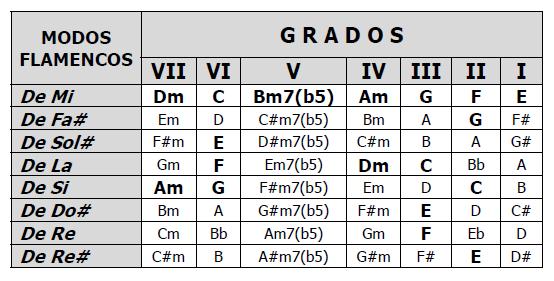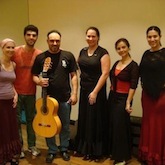Welcome to one of the most active flamenco sites on the Internet. Guests can read most posts but if you want to participate click here to register.
This site is dedicated to the memory of Paco de Lucía, Ron Mitchell, Guy Williams, Linda Elvira, Philip John Lee, Craig Eros, Ben Woods, David Serva and Tom Blackshear who went ahead of us.
We receive 12,200 visitors a month from 200 countries and 1.7 million page impressions a year. To advertise on this site please contact us.
|

|
|
the fifth degree in flamenco modes
|
You are logged in as Guest
|
|
Users viewing this topic: none
|
|
Login  | |
|

   
Ricardo
Posts: 14801
Joined: Dec. 14 2004
From: Washington DC

|
 RE: the fifth degree in flamenco modes (in reply to mezzo) RE: the fifth degree in flamenco modes (in reply to mezzo)
|
|
|
quote:
And the point is why these chords don't seems to appear in the chords progression while you accomp a solea or a tango? Are they replaced by others?
It is a weak chord to begin with because it does not contain a perfect 5th. In the context of flamenco, especially cante accomp, it already contains many notes of the tonic chord (only one is different when coupled with the actual tonic as bass note) so you get the feeling it is not "going anywhere" harmonically.
So in a sense the reason you don't notice it so much is because it is used SO OFTEN. Step out of por medio or por arriba for a minute. Think about taranta. The main chord has the M7b5 already in it, above the F# root. (C#m7b5 is C# E G B...the open strings bring it out clearly against the F# tonic).
Transpose that to E and you will find some nice places where when you rest on tonic, you can have that open suspended sound by hearing the A note instead of the G#. Chicuelo is one I can think of that uses that chord as tonic often. Also the open or barred version in A phrygian is common. Also Granaina and other tonalities in modern practice use this suspended "levante" sounding harmony.
As an aside, a big fight with dr Whitehead and Mcguire was regarding Manolo Sanlucar's assesment that it would be more "correct" to pass from this voicing (Bm7b5/E) to the Aminor chord for cante when this occurs, for the simple reason that it does not strongly tonicize the relative key of A minor, and keeps our ear more grounded to the E phrygian modality.
In the context of non phrygian type cantes, that are in MINOR keys, you will indeed find the chord used more often as described earlier ii-V-i....(Bm7b5-E7- Am). IN major keys it is used to borrow from the parrallel minor (in guajiras for example the same move, but end on A major for the cante)....or it can be used as a substitute and vice versa of F major (the VI) chord.
In guitar solo pieces it's usage is too numerous to mention. Check out Escudero's Impetu for an example of Em7b5 used extensively.
I have mentioned before that to me the andalusian cadence is just the circle of 5th progression of classical music in disguise. So in fact, you can use it that way for cante too. Think buleria:
Dm-C-Bb-A.
Dm (Gm) C (F) Bb (Em7b5) A
The typical sub for this progression for the Em7b5 would be Gm or Bb/Ab because those chords have perfect fiths in the voicing that simply sound better when resolving solidly to the A tonic.
Ricardo
_____________________________
CD's and transcriptions available here:
www.ricardomarlow.com
|
|
|
|
REPORT THIS POST AS INAPPROPRIATE |
Date Nov. 16 2011 17:42:06
 |
|

   
Ricardo
Posts: 14801
Joined: Dec. 14 2004
From: Washington DC

|
 RE: the fifth degree in flamenco modes (in reply to mezzo) RE: the fifth degree in flamenco modes (in reply to mezzo)
|
|
|
quote:
I understand what you said with the F#, but then i'm a bit lost with what you said in the next paragraph with the transposition in E, the bar in A and the B. Could you provide some example?
In E phrygian this chord:
0
3
2
3
2
0
The half dim 7 would be BDFA, if you leave off the third, then this chord is also effective the same way:
0
0
2
3
2
0
Barre 5th fret in A phrygian, again Chicuelo ended his buleria in Encuentro with this:
5
5
7
8
7
5
And por medio open see the last vid of Antonio Rey's buleria
0
3
3
2
0
x
or Paco arps this in El Tempul, notice the minor third of E-half dim is back:
3
3
3
2
0
X
in Granaina:
0
0
5
4
2
X
Imposing the diminshed chord , or half diminished, over the tonic gives a nice "open" sound with no third present. In a way the purpose in flamenco IS to give the "Taranta" vibe, and is a major reason why the different keys we play in also take on different "aire", but we can mimic the different aires associated with other keys, by clever voicings.
_____________________________
CD's and transcriptions available here:
www.ricardomarlow.com
|
|
|
|
REPORT THIS POST AS INAPPROPRIATE |
Date Nov. 16 2011 22:10:51
 |
|

  
mezzo
Posts: 1409
Joined: Feb. 18 2010
From: .fr

|
 RE: the fifth degree in flamenco modes (in reply to Ricardo) RE: the fifth degree in flamenco modes (in reply to Ricardo)
|
|
|
Thanks for that chords Ricardo.
Tomrocker you're welcome.
This info was already present on the foro, if you made search, you could find topics and posts explaining the various modes.
Nice thing is that table gives a good overview. But it's just super basic. It tells you the chord family but not precise if it's F7 or C9...
The D natural mode is also considered phrygian?
Coz what i notice is there are 7 degrees and 7 modes (8 with the D natural).
As for the scale pattern (for the picado) there are also 7 differents.
Regarding minor and major key for the cante, it would be nice if you or someone else could precise, following the same structure as the pic above, the chord/degree?
- - - - - - - - - - - - - -
Edit: I'd just to clarify something maybe unclear
quote:
mezzo:
So when resolving, we substitute the m7b5 chord.
And when we begin a progression, we avoid it. Using the A7 (passing chord) to land on Dm (according to the letra). (?)
What i meant was if the 1st degree is the resolution chord, the final chord of a progression.
What about the beginning of a progression?
In a solea de alcala (E) or a tientos (A) some of the letra begin with the E7 to Am or A7 to Dm.
So as I understand the trick, these E7 and A7 are not from the 1st degree, but they're the passing chord from V to IV. right?
The confuzion come from that these passing chords are from the same family as the 1st degree.
So as you said vm7b5 : "It is a weak chord to begin with because it does not contain a perfect 5th."
While starting a progression, guitaristas prefer to play the passing chords instead of the Vth? Or these chords are from the 1st degree?
quote:
a big fight with dr Whitehead and Mcguire ...
I remember that. Weird to fight like this just for a chord.
Btw my intention is not polemical, I'd just to understand what's going on with this Vth.
_____________________________
"The most important part of Flamenco is not in knowing how to interpret it. The higher art is in knowing how to listen." (Luis Agujetas)
|
|
|
|
REPORT THIS POST AS INAPPROPRIATE |
Date Nov. 17 2011 8:14:29
 |
|
 New Messages New Messages |
 No New Messages No New Messages |
 Hot Topic w/ New Messages Hot Topic w/ New Messages |
 Hot Topic w/o New Messages Hot Topic w/o New Messages |
 Locked w/ New Messages Locked w/ New Messages |
 Locked w/o New Messages Locked w/o New Messages |
|
 Post New Thread
Post New Thread
 Reply to Message
Reply to Message
 Post New Poll
Post New Poll
 Submit Vote
Submit Vote
 Delete My Own Post
Delete My Own Post
 Delete My Own Thread
Delete My Own Thread
 Rate Posts
Rate Posts
|
|
|
Forum Software powered by ASP Playground Advanced Edition 2.0.5
Copyright © 2000 - 2003 ASPPlayground.NET |
0.078125 secs.
|


 Printable Version
Printable Version










 ).
). 


 New Messages
New Messages No New Messages
No New Messages Hot Topic w/ New Messages
Hot Topic w/ New Messages Hot Topic w/o New Messages
Hot Topic w/o New Messages Locked w/ New Messages
Locked w/ New Messages Locked w/o New Messages
Locked w/o New Messages Post New Thread
Post New Thread